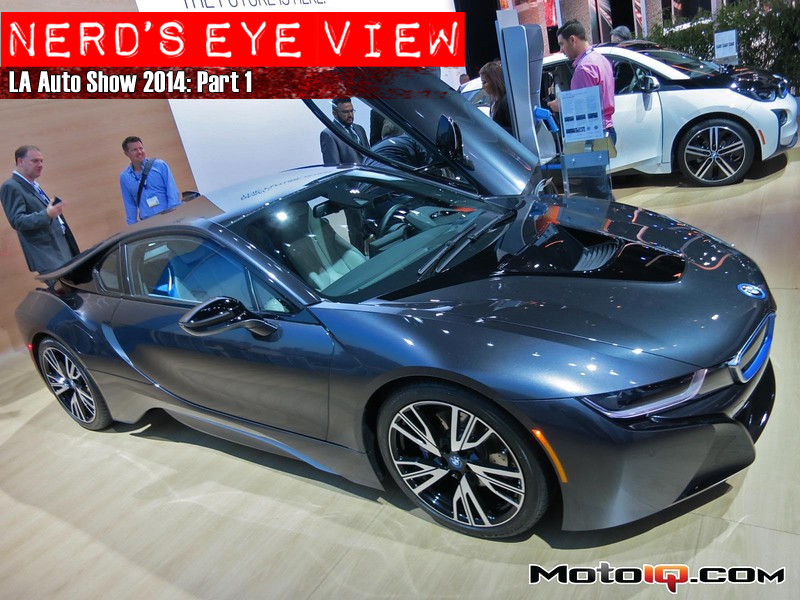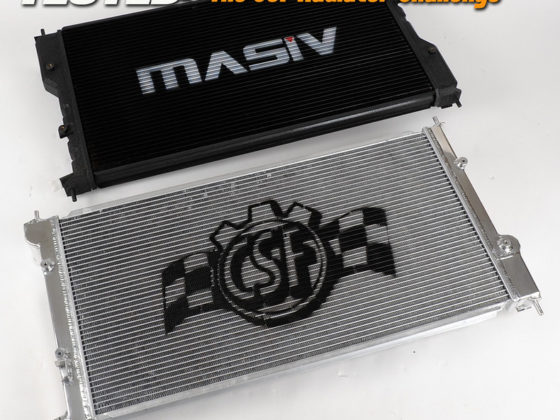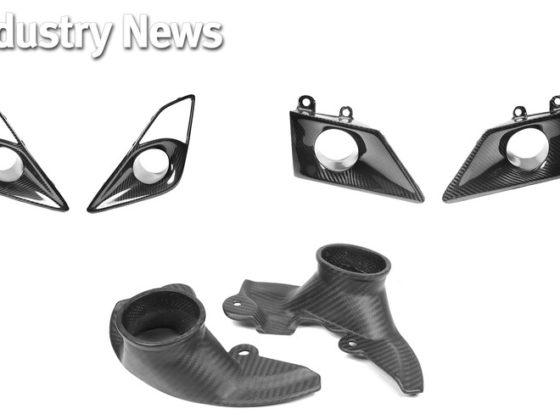,
 This is the new twin-turbo inline-6 cylinder engine powering the M3/M4. On top of the engine on the driver’s side is the air-to-water intercooler. Both turbos feed into one side (the two big tubes on the left) and combine at the outlet of the intercooler. As is typical in heat exchanger design for OEM applications, plastic end tanks are clamped onto the metal heat exchanger core. The plastic end tanks on intercoolers look like waffles as all the ribs are required to make the parts stiff and strong to resist ballooning from all the boost pressure. Coming out of the metal core of the intercooler are the two smaller coolant hoses taking coolant to a radiator mounted up front. One very significant piece in the engine bay is that massive carbon fiber brace. It connects at the two strut towers and the front of the engine bay basically putting a lid on the box that is the engine bay and making the whole structure much stiffer. Take a box from one of your holiday gifts with the lid off and see how flexible it is. Put the lid on and compare. The box should be stiffer and be more resistant to flexing with the lid on. Well, that’s what this brace should be doing too. That stamped metal plate bolted in the front of the engine bay should be doing a part in adding stiffness too.
This is the new twin-turbo inline-6 cylinder engine powering the M3/M4. On top of the engine on the driver’s side is the air-to-water intercooler. Both turbos feed into one side (the two big tubes on the left) and combine at the outlet of the intercooler. As is typical in heat exchanger design for OEM applications, plastic end tanks are clamped onto the metal heat exchanger core. The plastic end tanks on intercoolers look like waffles as all the ribs are required to make the parts stiff and strong to resist ballooning from all the boost pressure. Coming out of the metal core of the intercooler are the two smaller coolant hoses taking coolant to a radiator mounted up front. One very significant piece in the engine bay is that massive carbon fiber brace. It connects at the two strut towers and the front of the engine bay basically putting a lid on the box that is the engine bay and making the whole structure much stiffer. Take a box from one of your holiday gifts with the lid off and see how flexible it is. Put the lid on and compare. The box should be stiffer and be more resistant to flexing with the lid on. Well, that’s what this brace should be doing too. That stamped metal plate bolted in the front of the engine bay should be doing a part in adding stiffness too. With turbo cars, space for heat exchangers comes at a premium. Therefore, the M3/M4 uses the same concept as the M5 with a heat exchanger mounted low and horizontal in the front bumper opening area.
With turbo cars, space for heat exchangers comes at a premium. Therefore, the M3/M4 uses the same concept as the M5 with a heat exchanger mounted low and horizontal in the front bumper opening area. The air which goes into that low horizontal heat exchanger has to go out somewhere and that somewhere is out these vents underneath the car. Note to self, don’t drive the front of this car on top of any tall parking stops or curbs as it could be a very expensive repair.
The air which goes into that low horizontal heat exchanger has to go out somewhere and that somewhere is out these vents underneath the car. Note to self, don’t drive the front of this car on top of any tall parking stops or curbs as it could be a very expensive repair. I started noticing these rubber additions to engine bays which serve to seal off possible air pathways…. My guess is to reduce NVH due to wind noise. Behind that is some shiny aluminum which I believe the carbon fiber brace is bolted to. Hard to say exactly with all the darn plastic covers in engine bays these days.
I started noticing these rubber additions to engine bays which serve to seal off possible air pathways…. My guess is to reduce NVH due to wind noise. Behind that is some shiny aluminum which I believe the carbon fiber brace is bolted to. Hard to say exactly with all the darn plastic covers in engine bays these days. The German make that DID impress me was Mercedes! I’ve always been a BMW or Audi guy; you know, M3/M5s and RS4/RS6s. In the past, Mercedes has always been kinda like the stereotypical American musclecar, lots of brute force but lacking finesse and nimbleness. But that’s all starting to change at Mercedes (as it has with the Mustang and Camaro too). This new AMG-GT is a legit Porsche 911 fighter. My 911 owning buddy VK-san even remarked how the C-pillar is 911-esque. Well, that and he’d love to own this car.
The German make that DID impress me was Mercedes! I’ve always been a BMW or Audi guy; you know, M3/M5s and RS4/RS6s. In the past, Mercedes has always been kinda like the stereotypical American musclecar, lots of brute force but lacking finesse and nimbleness. But that’s all starting to change at Mercedes (as it has with the Mustang and Camaro too). This new AMG-GT is a legit Porsche 911 fighter. My 911 owning buddy VK-san even remarked how the C-pillar is 911-esque. Well, that and he’d love to own this car. Providing the go-power for the AMG-GT is a twin turbo V8 mounted VERY far back. The engine is rated at just over 500hp… keep that in mind. The front of the engine is actually behind that big plastic cover. Between the black cover and the silver cover at the back, you can see the compressor housings of the two turbos mounted in the V of the engine (now standard practice with BMW, Audi, and Mercedes). Those compressor housings are basically at the front of the engine, so you can see how the whole engine is located behind the front axles. The result is a 45/55 rearward biased weight distribution. Pretty amazing for a front engine car eh? Anyway, on either side of the black cover are the two air boxes grabbing air from a cold source at the front of the car. Then it’s a short path from the air boxes to the turbochargers. You can see how mounting the turbos up in the V of the engine is beneficial to performance and packaging of the air systems. The intake path for the turbos is short and direct resulting in minimum pressure drop for maximum performance. In front of the black cover are vents in the black plastic shroud at the front of the engine bay; keep those in mind as I’ll return to them.
Providing the go-power for the AMG-GT is a twin turbo V8 mounted VERY far back. The engine is rated at just over 500hp… keep that in mind. The front of the engine is actually behind that big plastic cover. Between the black cover and the silver cover at the back, you can see the compressor housings of the two turbos mounted in the V of the engine (now standard practice with BMW, Audi, and Mercedes). Those compressor housings are basically at the front of the engine, so you can see how the whole engine is located behind the front axles. The result is a 45/55 rearward biased weight distribution. Pretty amazing for a front engine car eh? Anyway, on either side of the black cover are the two air boxes grabbing air from a cold source at the front of the car. Then it’s a short path from the air boxes to the turbochargers. You can see how mounting the turbos up in the V of the engine is beneficial to performance and packaging of the air systems. The intake path for the turbos is short and direct resulting in minimum pressure drop for maximum performance. In front of the black cover are vents in the black plastic shroud at the front of the engine bay; keep those in mind as I’ll return to them.


